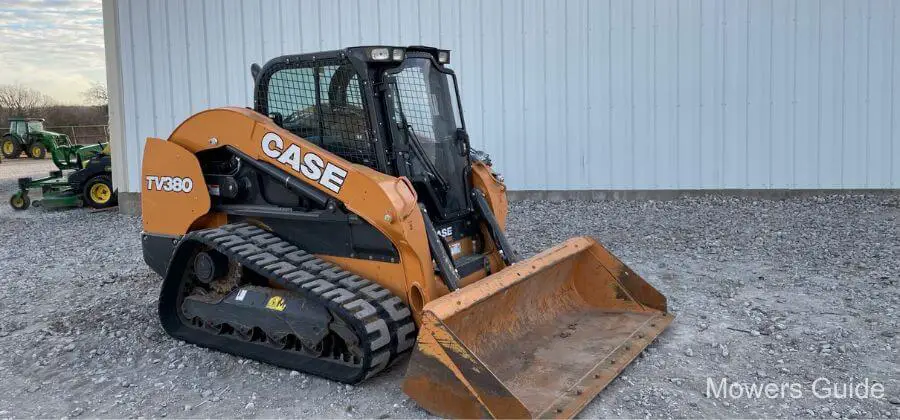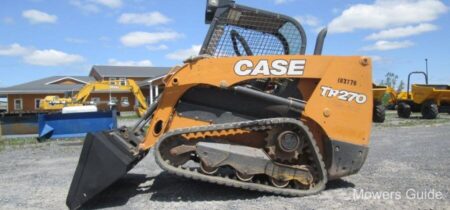You wheel your Case TV380 out of the garage and turn the key, but instead of the familiar rumble of the engine, there is only silence. You try again, but still nothing. No sputtering, no clicking, just a blank dashboard. With a frustrated sigh, you realize that your trusty skid loader won’t start.
The Case TV380 appears to be a trustworthy alternative with excellent system performance. This is one of the most effective compact truck loaders for your requirements. As a result, the Case TV380 is a fantastic choice if you ever need a skid loader that can do some difficult tasks.
Before you load up your track loader for a costly repair shop visit, there are a few common Case TV380 skid steer problems you can check yourself. As a long-time owner of this model, you’ve probably encountered a few of these issues before and fixed them with a few basic tools and a little mechanical know-how. With some troubleshooting, you’ll be back to your regular schedule in no time.
Case TV380 Problems with Solutions
The Case TV380 is a compact track loader designed for construction and landscaping tasks. Over the course of its use, some users have reported issues or challenges. Here are five common problems faced by operators of the Case TV380, along with potential solutions:
1) Communication Loss
When your skid steer’s control module and instrument cluster cannot communicate with one another, the error code 9406 is produced. The device stops functioning when this error appears and finally turns off. Do a seat check.
There is a malfunctioning safety switch there. This switch can be used to determine where the error code originated. Therefore, checking the cable connection to your seat is the easiest way to solve this issue.
Numerous users have reported experiencing the same issue after changing their weight on the skid-steer seat, according to the evaluations. Even the smallest movement you make on the seat while the switch is engaged again can cause the unit to turn off and on.
When seated in the skid-steer seat, all you have to do is make sure the switch is always in the engaged position. You must adjust the safety switch for that. The Case TV380’s 9406 fault code can be resolved using this method.
2) Checking the Spark Plug and Air Filter
The spark plug and air filter are two of the most common reasons for a Case TV380 compact loader not starting. Before you start replacing expensive parts, check these basic components first.
Spark Plug
The spark plug ignites the fuel and air mixture in the engine. If it’s damaged or worn out, your loader won’t start. Remove the spark plug and inspect it. Look for any cracks in the ceramic insulator or excessive wear on the electrodes. If it looks very worn or damaged, replace it. For a new plug, set the gap between the electrodes to 30 inches.
Install the spark plug and try starting your skid steer. If it still won’t start, it’s on to the air filter.
Air Filter
The air filter prevents debris from entering the carburetor and engine. If clogged or dirty, it reduces airflow and prevents enough fuel from entering the carburetor. Remove the air filter and hold it up to the light. If very little light passes through, it needs replacement. You should replace your loader’s air filter once a season or every 25–50 hours of use.
Install a new air filter and try starting your Case TV380. If it still won’t start, you may have additional issues with the carburetor or fuel system that require diagnosis and repair by a small engine mechanic. But in many cases, a new spark plug and air filter do the trick to get a reluctant track loader running again.
3) Troubleshooting Fuel System Issues
If your TV380 Case won’t start, it could be an issue with the fuel system. Here are some things to check:
Fuel Level
Make sure you have enough fresh gasoline in the tank. Old or stale fuel loses octane and becomes gummy, clogging up the carburetor. Fill the tank with new, clean fuel. If the compact track loader has been sitting for a while, it’s also a good idea to drain the old fuel from the carburetor float bowl.
Fuel Filter
The fuel filter removes any debris from the gasoline before it enters the carburetor. If it’s clogged, it won’t allow enough fuel to flow through. Remove the fuel filter—you’ll find it inline along the fuel hose between the tank and carburetor—and replace it with a new one.
Carburetor
The carburetor mixes fuel with air to power the engine. If it’s dirty or clogged, it won’t function properly. Remove the carburetor bowl and clean out any built-up debris with carburetor cleaner spray and pipe cleaners. Reassemble and adjust the carburetor to the proper specifications. You may need to refer to your owner’s manual for this.
Fuel Line
Check that the rubber fuel line connecting the tank to the carburetor isn’t cracked, damaged, or leaking. Any air leaks will prevent fuel from getting to the carburetor. Replace the fuel line if needed.
Fuel Shut-Off Valve
Some loaders have a fuel shut-off valve, usually near the carburetor—ensure it’s turned to the “open” position to allow fuel flow. If stuck or damaged, the skid steer won’t start. Try freeing up or replacing the shut-off valve.
With a few troubleshooting steps, you should be able to get your Case TV380 track loader started again in no time.
4) Testing the Start Switch and Safety Interlocks
If your Case TV380 won’t start, the problem could lie with the start switch or interlock safety mechanisms. These prevent the skid steer from accidentally starting up when you’re not ready. Let’s check them out.
Start Switch
The start switch sends power to the starter motor when you turn the key or push the button to start the track loader. If it’s faulty, the starter won’t engage. Try starting your TV380 Case skid steer several times. If the switch doesn’t seem to click or you don’t hear the starter motor humming, the start switch likely needs replacement.
Safety Interlocks
Modern loaders have mechanisms that prevent it from starting unless certain conditions are met like the blade control lever being disengaged or the operator being present. The interlock switch is connected to these mechanisms. If it’s malfunctioning, it will prevent the loader from starting even when the proper conditions are met.
To test, try starting the skid steer. If it still won’t start, the interlock switch may need servicing or replacement. Disconnect the spark plug wire and consult your owner’s manual for details on inspecting and testing the specific interlocks and switches on your Case TV380 model.
5) Loader is Not Responding to the Joystick
The loader joystick controls the front bucket on your Case TV380. If it’s not responding, a few issues could be preventing the loader from operating properly.
Check the hydraulic fluid level. The hydraulic system powers the loader, so if the fluid is low, the loader won’t function. Locate the hydraulic fluid reservoir under the seat and check that the level is in the acceptable range. Refill if necessary.
Inspect the joystick and wiring. The joystick sends signals to the hydraulic valves to control loader movement. If the joystick or wiring is damaged, it won’t be able to communicate with the hydraulics. Look for any visible damage to the joystick, wiring, or connections. Have a certified case technician test and repair or replace faulty parts.
Air may be trapped in the hydraulic system. Air in the hydraulic lines blocks the flow of fluid, preventing the loader from operating. To purge the air from the system, slowly move the joystick in all directions, holding each position for 30 seconds. Repeat several times. This should release any trapped air and restore function. If the problem continues, have the hydraulics checked by a technician.
The hydraulic control valve could be malfunctioning. The control valve directs hydraulic fluid to the necessary lines and cylinders to operate the loader. If the valve sticks or fails, it won’t respond to input from the joystick. In this case, a replacement of the hydraulic control valve will be required to get your Case TV380 loader functioning again.
By checking these common issues, you may be able to resolve a non-responsive loader joystick yourself. However, if the problem is not fixed or you suspect a larger hydraulic system failure, contact your local Case dealer for a full diagnostic and repair to get your loader back in working order.
When to Take Your Case TV380 to a Mechanic for Repairs?
At some point, every track loader needs a tune-up or repair. For minor issues with your TV380, there are a few things you can try yourself to get it running again. However, for major problems or if you’ve tried everything and it’s still not working, it’s best to take it to a certified mechanic. They have the proper training, tools, and parts to diagnose and fix the issue.
Loss of Power
If your skid steer starts but won’t keep running or is struggling, it could be a sign the air filter or fuel filter needs replacing, the carburetor needs adjustment, or the valves are stuck. A mechanic can test engine performance, replace worn parts, and get your loader running at full power again.
Unusual Noises
Loud knocking, squealing, or grinding noises usually mean there’s an internal engine issue that requires mechanical repair. Continuing to operate the loader could severely damage it. It’s best to stop using it immediately and take it to a certified mechanic for diagnosis and servicing.
Rather than continuing to struggle with a faulty skid yourself, take it to a professional. They have the proper tools, training, and parts to get your TV380 back in working order so you can get back to enjoying your lifting. It will save you time, frustration, and possibly money in the long run. When in doubt, call a mechanic!
Conclusion
Don’t panic if Case TV380 is not starting up; these machines can be temperamental at times. But by going through each of the potential issues systematically, you’ll get your compact track loader back to mint condition and your trail looking pristine again in no time.
If all else fails, don’t hesitate to call in a mechanic to take a look. They’re the real experts and can probably diagnose the problems quickly. But with some patience and persistence, you’ve got this.
FAQs
How much power does the TV380 casing have a rating for?
To put it simply, trust CASE to provide compact track loaders that go above and beyond the requirements.3,800 lb (1 723 kg) is the TV380’s rated operating capacity (ROC), while the TR340’s ROC is 3,400 lb (1 542 kg).
Which skid loader is the largest?
The largest and strongest compact track loader ever made is the CASE TV620B. Run the attachments with a lot of power. the high trucks with cargo. Get to work on the most difficult earthmoving applications.
What is the horsepower of a TV370?
With its rated operational capacity (3,700 pounds at 50% tipping load), reach, and 74 horsepower, maintenance-free Tier 4 Final emissions system, it can load, lift, and carry with the big boys.
Related Post:
6 Common Case TR270 Problems With Effective Solutions
For more tractor problems and fixes visit here and for more guides related to mowers visit Mowers Guide











